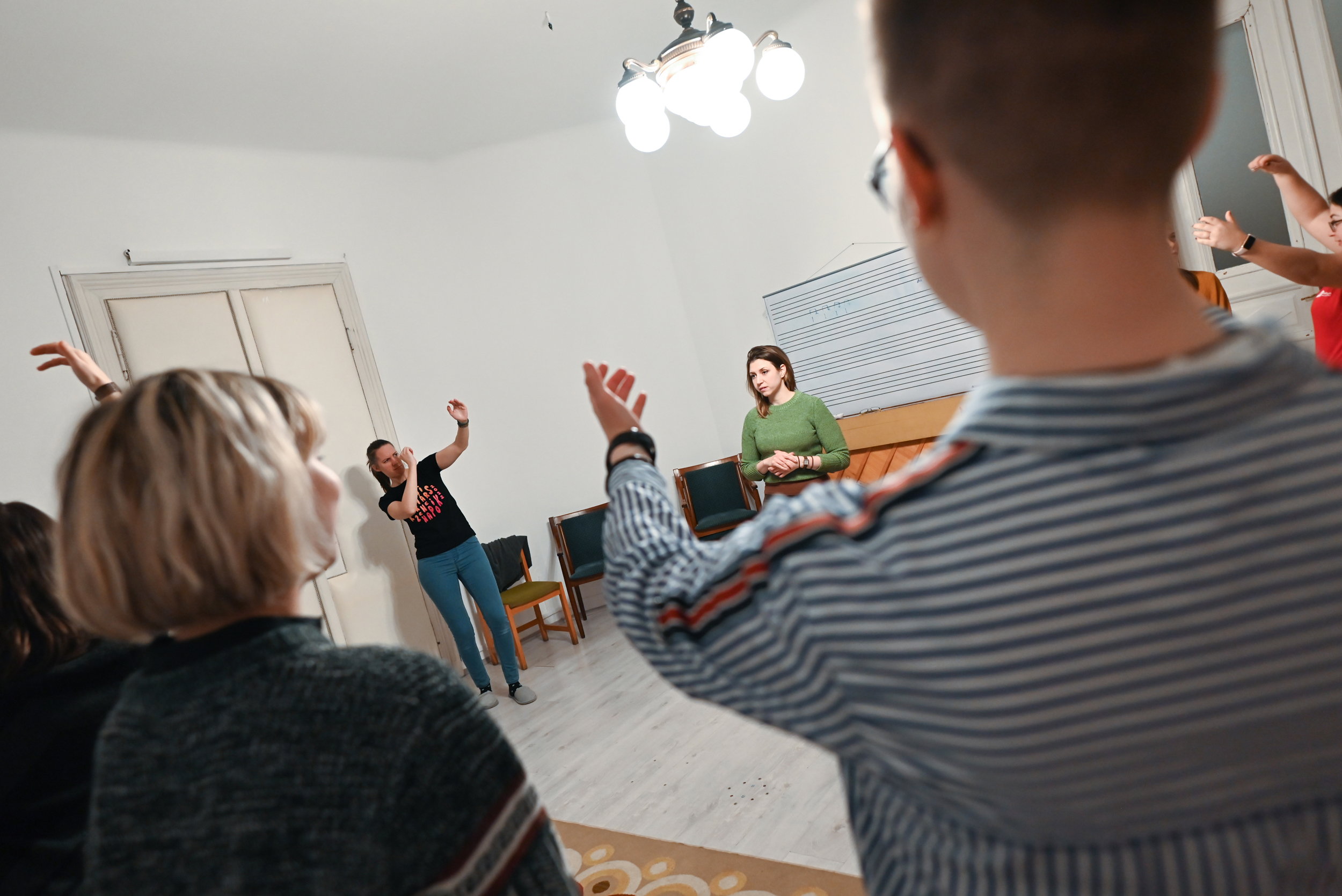by immusic | Nov 28, 2022
Category
vocal
Age
12+
Number of participants
3-15
Duration
approx. 20 min.
Working method
group work
Musical abilities of the trainers
12 3 4 5 6
Competences
- creativity
- improvisation
- attention
- collaboration
- cooperation
- social sensitivity
Hunt the Object
Facilitating orientation with vocal sounds in the form of a short game, following different vocal changes in space. Vocal version of „The seeker”, rhythmic and instrumental game (40).
AIM
The goal of the game is to learn how vocal sounds can be used in many different interpretations, and how to navigate with their help. It helps them learn how to express their feelings, how to improvise, how to enjoy music and develop this within a group
that develops social skills and teamwork.
Description
The instructor shows the participants the object to hunt that can be anything (e.g. a coin). One participant goes out of the room for a few seconds. While he/she is there, the group hides the object somewhere, then they invite her/him back to the classroom.
The group makes a long ‘La’ sound while the participant is hunting for the object. They can vary their ‘La’ sound according to pitch (high pitch means close, low pitch means far) and dynamics (loud means close, quiet means far away). So if he/she is close to the
object, they should sing ‘La’ at a higher pitch and louder. If he/she is far away, they sing ‘La’ at a lower pitch and more quiet. By listening to them, the hunter should be able to find the hidden object.
Participants can also use a song or melody while one of them is trying to find the object.
by immusic | Nov 28, 2022
Category
vocal
rhythmic
instrumental
Age
12+
Number of participants
5-20
Duration
approx. 20 min.
Working method
group work
Musical abilities of the trainers
12 3 4 5 6
EQUIPMENT
AND INSTRUMENTS
- optional: any type
of instrument
Competences
- improvisation
- creativity
- collaboration
- attention
- cooperation
- concentration
- sense of rhythm
Bead String
Short funny game to develop musical creativity and memory.
AIM
The goal of the game is to develop musical creativity, to promote thinking that always presents new and variation possibilities during the game. Musical memory improvement affects learning abilities in all other areas as well.
Description
The participants stand or sit in a circle. The facilitator provides instructions on the game and which set of sounds can be used during the play.
First participant sings or play a sound.
After that the next participant repeats the sound and adds one.
The next repeats the 2 sounds and adds another sound.
And it goes round the circle.
The goal is to make the longest line of sounds, longest “string of bead.”
Level up!
If the group’s level of knowledge and experience allows it, the game can also run to the point where a common piece can be created.
COMMENTS FOR FACILITATORS
During the activities be care of the steady beat.
by immusic | Nov 28, 2022
Category
vocal
instrumental
Age
8+
Number of participants
2-15
Duration
approx. 20 min.
Working method
- group work
- it can be played in pairt
Musical abilities of the trainers
12 3 4 5 6
Equipment and instruments
- optional: any type of instrument
Competences
- improvisation
- creativity
- memory
- collaboration
- attention
- cooperation
- concentration
Playback
A short and simple game based on creativity and improvisation.
AIM
During the game, the development of improvisational skills and creativity is the most important goal, while the musical memory also improves a lot, and paying attention to each other greatly affects social skills.
Description
The participants stand or sit in a circle. The facilitator provides instructions on the game and which set of sounds can be used during the play.
First participant sings or plays a set of sounds. First of all, it is worth choosing a simple melody that varies 2-3 notes.
After that the next participant repeats the exact same set of sounds. If this participant sang or played correctly then chooses who will go next (cannot choose the one sang/played before) and improvises a set of sounds, starting with the same note as the last set of sound ended with.
The next participant repeats the same as the player before.
During the game if somebody cannot repeat the set of sounds goes out of the circle as being out of the game. The game ends when only one participant remains in the circle.
by immusic | Nov 28, 2022
Category
vocal
instrumental
Age
12+
Number of participants
5-25
Duration
approx. 20 min.
Working method
group work
Musical abilities of the trainers
12 3 4 5 6
Competences
- creativity
- improvisation
- attention
- movement coordination
- cooperation
- social sensitivity
Sculpture Game
A funny game based on movement coordination and quick reaction
AIM
During the game, moving to the music, reacting quickly to silence, and turning into a statue all strengthen movement coordination, and at the same time this game is extremely enjoyable and has team-building benefits.
Description
The players line up next to each other at the theoretical starting line. Several meters in front of them, a participant is standing backwards towards them.
The aim of the game is for the participants on the starting line to reach and touch the shoulder of the lone player. Whoever achieves this wins. The player in front starts playing music (sings, plays an instrument, or even plays music from an application).
Players standing in the line can only move during the music and approach the target. However, as soon as the music stops, they must avoid all movement and become a statue.
The individual player turns quickly, as his goal is to discover who has moved into it. When the music stops, he looks back and if he sees someone moving, those participants must go back to the starting line (or they are out of the game, both versions can be played).
by immusic | Nov 28, 2022
Category
rhythmic
Age
10+
Number of participants
5-30
Duration
approx. 10 min.
Working method
group work
Musical abilities of the trainers
12 3 4 5 6
EQUIPMENT
AND INSTRUMENTS
- optional: any type
of instrument
Competences
- creativity
- improvisation
- attention
- cooperation
- concentration
- rhythm recognition
- sense of rhythm
Check My Beat
A simple game that encourages concentration, keeping the pace, and is based on creativity.
AIM
The goal of the game is to create mutual attention, to promote teamwork and cooperation, while also developing a sense of rhythm and rhythm recognition. Figuring out rhythm formulas develops creativity, and imitation strengthens musical memory.
Description
1. Participants are standing in a circle.
2. The instructor says in a rhythmic way: Here is my rhythm now, check my beat! and claps the steady beat four times.
3. The participants answer together in a rhythmic way, too: We got your rhythm now, here is your beat! and they clap the same.
4. The next person clockwise will be the next one who finds out a new formula and the others will repeat it together and so on.
The formula always contains four quarters, but it can be performed in many ways, e.g. with clicking, with tapping a body part, with la-la. Alternatively, these activities can be mixed.






Recent Comments